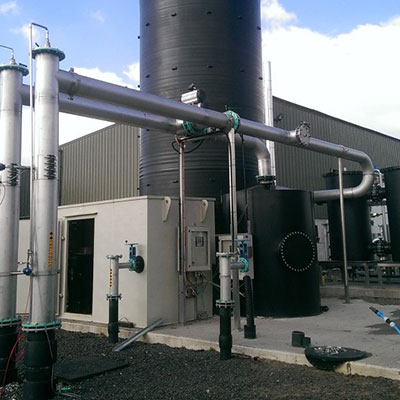Project Information
Background:
The ReFood facility processes 120,000 TPA of waste food using an anaerobic digestion plant, to generate 5 MW of renewable energy which is injected into the National gas grid.
Application:
Pre-treatment of biogas to remove high H2S and VOCs prior to the gas entering the gas to grid upgrading system. The challenges at Widnes are unique and required a large amount of study and up front design to produce a bespoke system capable of dealing with the variable gas constituents and loads that may fluctuate on a day to day basis. Additionally the system had to operate on a very low oxygen level of 0.4% to ensure that there was no more than 1% Oxygen in the biomethane when injected into the grid.
Solution:
To design, manufacture, supply, install and commission a Biogas Desulphurisation System to remove high levels of H2S and VOC compounds. Due to the lack of available oxygen, which biological systems rely on to work effectively, the odour control system selected to remove the bulk of the H2S is unique and specifically designed to operate at low oxygen concentrations with minimal water consumption.
Performance:
The biological system reduced the incoming 1200 ppm H2S levels down to <200ppm, an activated carbon scrubber then lowers to <50 ppm H2S, however because of the presence of VOC’s in the system a further polishing stage of activated carbon was installed to prevent any VOC related odours from impacting the odour of the biomethane.
Data:
Flow Rate: 2000 Nm3/hr
H2S Loading: 1,200 ppm
Other Contaminants: VOC’s
Oxygen Content: 0.2%
Products featured in this case study
 Biological Desulphurisation
Biological Desulphurisation

